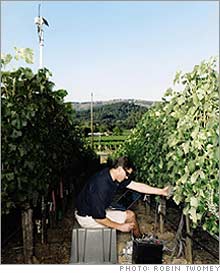|
The grapes of math Can high-tech tools help make better wine? Some Silicon Valley refugees think so.
NEW YORK (Fortune) -- "Andy Grove had a saying when I worked at Intel," says Chuck McMinn, a Silicon Valley veteran who spent 25 years at the chipmaker and a series of startups. "If you can't measure it, you can't improve it." That statement surely wouldn't raise eyebrows if the subject were microchips, but it's nowhere close: McMinn is talking about wine.
He runs through the high-tech gadgetry dotting Vineyard 29, his Napa Valley winery, which was completed in 2002. There are moisture probes monitoring water use and weather stations that send statistics to a Web site. His consulting winemaker, Philippe Melka, has enlisted a French Ph.D. student to install sap-flow sensors on some vines to track how much water they use, information that could help refine irrigation techniques down the line. The property is almost off the energy grid, producing electricity with microturbines that burn natural gas on the roof. Excess energy is then used to warm water for heating and cool it for air conditioning. In the winery he has installed a system called Tanknet, linking thermostats on the tanks to Web-based software to regulate fermentation and aging. During the harvest, when every degree change is crucial, the winemakers can watch the tanks - virtually - through the night. And in the lab adjacent to the winery there's a new $15,000 machine called a titrator, used to test the wines for everything from sulfur content to pH balance. "What we're doing is making wine the old-fashioned way," says McMinn. "We just use technology to do it." From memory chips to merlot For as long as there has been tech in Silicon Valley, successful refugees have embarked on second careers in wine making. But McMinn is part of a new breed: Instead of leaving tech behind, they're obsessed with how it can bring an age-old art into the 21st century. Roger Boulton, a professor of enology at the University of California at Davis, calls this approach to wine "quantitative, data-driven, hypothesis thinking." He teaches chemical engineering and is firmly in favor of winemakers' adopting high-tech tools. The approach used to be, "I've got to go to Italy and see what the guy does with the Sangiovese," notes Boulton. But former engineers know that "we're only going to understand these things if we have data." That's certainly what Bill Murphy is after. As he brings his electric golf cart to a screeching halt, he gestures at a row of grapevines in his vineyard, Clos LaChance, at the base of the Santa Cruz Mountains. "Those are happy vines," he exclaims before shooting down a hill and stopping again. This time the plants aren't quite so happy - -in fact, they're tiny compared with their thriving neighbors. "Drainage," explains Murphy. "See the depression? It was too wet." How can he tell? The network of moisture monitors in the vineyard had signaled a water overload underground, and inspection on foot confirmed unhealthily muddy soil. "[Tech] gives you more levers to pull, more tools to make better wine," says Murphy, who coined the term "LaserJet" for HP in the 1980s and retired as the company's director of Internet marketing in 2000. "These are not toys." Indeed, Silicon Valley's lifeblood, software, is fast infiltrating places like Napa Valley, with systems like Tanknet and Logix (which Murphy uses at Clos LaChance) now common in many vineyards. Tanknet, launched five years ago, now manages software at 80 vineyards and is adding 20 to 30 new clients each year. But Murphy is most excited about Conformia, a program that keeps track of every detail - from which grapes were used to how many days it aged - about each wine he produces. That has vastly simplified filling out the government reporting forms that wineries submit every month. "It allows Stephen [Tebb, the winemaker] to do wine making as opposed to record-keeping," says Murphy. But does measuring, monitoring, and recording every step of the process make for better wine? After all, the French have made wonderful wines for centuries without irrigation, much less wireless networking. "The French learned empirically over hundreds and hundreds of years - I don't have hundreds of years," says Murphy. The tech means "we can learn so much faster." The point isn't just perfecting this year's vintage, it's quantifying as many of the variables as possible and learning quickly from past mistakes. That means during a future late-July heat wave, winemakers will be able to revisit this year's statistics, look at the 2006 wines and figure out how to adapt to the conditions. "Those technologies make the business better," Murphy adds. But then the truth comes out: "Plus, they're cool!" Taste Test Enough about probes and sensors - how's the wine? Paul Roberts, the legendary French Laundry restaurant's master sommelier, has high hopes for the future of wine made by tech refugees. "The new innovators in the valley are going to be the people with the most money, and the people with the most money are now tech people," he says. Here are three wines to try: Clos De La Tech Want to add a literal touch of silicon to your collection? The wines made by T.J. Rodgers are adorned with the most successful chips from his company, Cypress Semiconductor. Limited supply; $101.50, closdelatech.com Clos LaChance The 2005 viognier is a fruity white wine that practically begs to be drunk on a patio (or on vacation); it's peachy and distinctly honey-scented. $19, closlachance.com Vineyard 29 The 2002 Aida red wine, made with a blend of cabernet and merlot grapes from McMinn's second vineyard property, explodes with blackberry and dark-chocolate flavors. Roberts says, "They're really hitting on all cylinders and making some exceptional wines." $120, vineyard29.com _____________________ More from the Good Life: |
|

